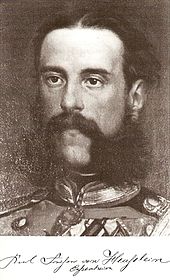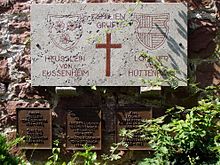Carl Leo Donat Heusslein from Eußenheim
Carl Johann Leo August Donat Freiherr Heusslein von Eußenheim (born April 14, 1838 in Kissingen , † September 25, 1870 in Messincourt , Arrondissement Sedan , France ) was a Bavarian officer and the last of his line.
Life
Carl Leo Heusslein came from a Lower Franconian noble family with ancestral home in Eußenheim and was the son of the landowner Philipp Heusslein von Eußenheim († 1870) and Mathilde von Syberg. His parents separated three years after he was born. He completed four classes of the Latin school and then the 3rd course of the trade school.
With the desire to become an officer, Heusslein joined the 13th Infantry Regiment "Kaiser Franz Joseph von Österreich" of the Bavarian Army on April 27, 1855 in Bayreuth as a volunteer cadet at the age of 18 . On October 1st, 1855, as requested, he came to the 5th Chevauleger Regiment “von Leiningen” , as he “knows something about shoeing ” . Due to the unusual efforts, Heusslein fell ill in 1858 and was allowed to quit the army on May 1, 1859, in exchange for a substitute because of a lung disease.
But he did not want to be bored at home in Kissingen ("My life and restless mind lacked seeing the world.") And on September 4th, 1862, he set out for Egypt , which was very popular with the English at the time because of its hot and dry climate Whereabouts in the case of lung diseases. Presumably Heusslein also wanted to cure his lung disease there. His military knowledge and skills, but also his knowledge of French, English, Spanish and Italian made this adventurous and dangerous journey easier for him, which unexpectedly also led him to India and Burma , as his entries in his travel diary clearly show: “They are sketches that I bring .... they contain experiences of the journey, not described scientifically .... how I found it, what I encountered, what I experienced, I try to reproduce. "
Via Munich and Vienna we went to Trieste , from there we went on October 12th by mail steamer past Corfu to Alexandria . On board he met Ferdinand Marie Vicomte de Lesseps , the builder of the Suez Canal , and two English officers who persuaded him to continue to India. On October 17, the small tour group disembarked from the ship in Alexandria and took the train to Cairo . After a few days' stay (“I haven't seen any acquaintances here, not even from Kissingen”) we went by train through the desert to Suez . There he boarded the Indian steamer “Naurelia” with the two Englishmen, which brought them to Ceylon in 16 days with arrival in Port de Galle . He rode to Colombo on horseback, and shot his lunch of partridges or pigeons himself with his shotgun . Later he traveled to Madras in India and to Rangoon in Burma.
He returned shortly to Kissingen and Würzburg, but went on his next adventure trip to Mexico in the fall of 1864 , to see what Napoléon III had given him. Archduke Ferdinand Maximilian of Austria appointed by France as Mexican emperor to support the rebels under Benito Juárez . On the way to the capital, he freed the apostolic nuncio Pier Francesco Meglia from robber hands, for which he received a silver rosary from Pope Pius IX. was awarded the Commander's Cross of the Papal Order of Gregory .
In Mexico he joined a French Zouave regiment looking for guerrillas as a volunteer . He reported about his experiences from Mexico in an article in the "Neue Würzburger Zeitung" on January 20, 1865. Heusslein only returned to his homeland at the end of 1865 and lived in Würzburg.
But when the danger of a war with Prussia increased at the beginning of 1866 , Heusslein joined the 9th Infantry Regiment "Wrede" in Würzburg on May 16 , where he was first as Corporal II. Class and then from June 18, 1866 as a second lieutenant served in the 6th Chevauleger Regiment . As a participant in the war he received the army memorial .
He also took part in the war against France with his regiment that now has the addition "Grand Duke Konstantin Nikolajewitsch". On the march he learned of his father's death and then went to the battle of Sedan . On this day (September 1, 1870) he received from General Ludwig von der Tann-Rathsamhausen the order, as the regimental history says, “to know about the expected intervention of the Maas army marching under the orders of Crown Prince Albert of Saxony to procure and to report about it. Heusslein chased past the enemy skirmishers with four Chevaulegers in heavy rifle and mitrailleuse fire, and after he had done his job, he returned with the joyful news that the Saxons would soon arrive. The horse of Freiherr von Heusslein, who was himself uninjured, showed a large number of grazing shots and was bleeding from no fewer than 23 wounds. Because of this news, the Bavarian troops held out and thus contributed to the victory of Sedan. "
However, due to the exertion or an incipient typhoid infection, Heusslein died at the age of 32 on September 25 in the villa of the Marquis Paquais de la Granière in Messincourt near Sedan . The 6th Chevauleger Regiment reported to the General Command in Würzburg that Lieutenant Heusslein von Eußenheim on “25. September 1870, 6 1/2 in the morning in Messincourt, Ardennes department, Arrondissement de Sedan died of a nervous fever and was buried there ”.
Only later, with great difficulty, was his body transferred to his hometown of Kissingen in Lower Franconia , laid out in the family castle, today's (new) town hall , at the request of the Kissingen citizens , and buried in the chapel cemetery on November 14, 1870 with the greatest sympathy of the population . The Kissinger “ Saal-Zeitung ” reported the following day that the coffin, which was decorated with medals, weapons and helmets, was “followed by the local officers, civil servants, a department of the fire brigade , the song board and an extremely large number of residents from all classes”. As usual, when a noble family died out with the last male descendant, the family coat of arms was broken and added to the crypt as a symbolic symbol. This ended the 300-year family history of the Heusslein von Eußenheim in Kissingen.
Posthumously he was awarded the Knight's Cross II. Class of the Order of Military Merit together with the war memorial for the French campaign of 1870/71. In recognition of Heusslein’s services, King Ludwig II of Bavaria approved that the sister’s family and their descendants could now use the double name “Lochner von Hüttenbach called Heusslein von Eußenheim” .
literature
- Gerhard Wulz: The chapel cemetery in Bad Kissingen. A guide with short biographies. Bad Kissingen 2001. ISBN 3-934912-04-4 .
- Gerhard Wulz: Carl Johann Leo August Donat Freiherr Heusslein von Eußenheim (1838-1870). In: Franconian pictures of life. Volume 21, Society for Franconian History (ed.), 2006.
See also
| personal data | |
|---|---|
| SURNAME | Heusslein von Eußenheim, Carl Leo Donat |
| ALTERNATIVE NAMES | Heußlein von Eußenheim, Carl Johann Leo August Donat Freiherr (full name) |
| BRIEF DESCRIPTION | Bavarian officer |
| DATE OF BIRTH | April 14, 1838 |
| PLACE OF BIRTH | Bad Kissingen , Lower Franconia |
| DATE OF DEATH | September 25, 1870 |
| Place of death | Messincourt , Arrondissement Sedan , France |


